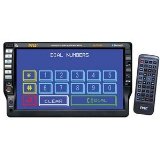 PYLE PLD70BT 7-Inch TFT Touch Screen DVD/VCD/CD/MP3/CD-R/USB/AM/FM/RDS Receiver and Bluetooth System
PYLE PLD70BT 7-Inch TFT Touch Screen DVD/VCD/CD/MP3/CD-R/USB/AM/FM/RDS Receiver and Bluetooth System
PYLE PLVW17IW 17” In-Wall Mount TFT LCD Flat Panel Monitor For Home & Mobile Use
Amp Smarts:
Amplifiers are devices that take a teeny tiny audio signal from a pre-amp, some power from your battery, and pass it on as a big big audio signal to drive speakers.
The most important piece of advice I can give to you is to buy lots of power. To get the cleanest sound, it is absolutely essential to buy as much power as you can afford.
Here are some terms that you’ll need to know when evaluating car audio amplifiers.
Watt: A watt is a measurment of power. Power is the ability to do work. In the case of amplifiers, the work is to move a speaker. Amplifiers come in all power ranges, from 20 watts per channel up to thousands per channel. When it comes to amplifiers, watts are described two ways:
RMS: An amp’s power rating might say: 75W RMS x 4 CH @ 4Ω 14.4V
This means that the amp is capable of 75 watts into 4 channels with 4 ohm speakers, and 14.4V of voltage. This amp is capable of providing that power if all of those conditions are met at all times. The truth is, even if you design your system to meet all of those conditions, it will not at all times. Speakers’ impedences (measured in ohms, or Ω) change constantly while operating. Amps don’t necessarilly put out the same power all of the time either, for example when a bass track is playing versus a much quieter track.
WHEN BUYING AN AMP, LOOK AT IT’S POWER RATING AS A MARKER FOR YOUR AMP’S CAPABILITY RATHER THAN WHAT IS LIKELY TO PUT OUT AT ALL TIMES.
However, I must also say that an amp’s RMS rating is the one piece of information to look for to determine an amp’s power.
CEA Compliant Power Output: This is (hopefully) going to become the industry standard for determining an amp’s power output. This allows you to accurately compare two amps to each other, because you know that they were tested under the same conditions. To know why this is a good thing, click here…
MAX:
Right under an amp’s RMS rating, you’ll see an amp’s “MAX” rating. It is often double the RMS rating. The MAX rating is pure junk. Never pay attention to the max rating because it only shows what the amp is capable of in a laboratory setting. That kind of environment cannot be reproduced in the auto, and therefore the rating is misleading. An amp’s max rating is proably about 50% more than the RMS. Never buy an amp based on it’s Max rating. Ok, and lastly, because this makes you look like a total jerk, never ever ever say your amp is a 1000 watt amp because it has a max 1000 watt sticker on it, and ESPECIALLY if you bought your amp at the swap meet. 1000 watt amps are BIG and HEAVY.
Anyway, in summation, never buy an amp based on it’s MAX rating.
CEA Compliant Power: (CEA=Consumer Electronics Association) This spec (if your amplifier includes it) is a new rating. The goals of this rating are to give a useful reference for amp comparison. In the “bad old days”, amp manufacturers could pretty much claim whatever power output they wanted without specifying the testing methods. The CEA rating changes that. The CEA compliant power output specifies what power output you can expect when the following criteria are met: 14.4V, 4 Ohm speaker load and 1% distortion. You can now fairly compare two amplifiers to each other because you know they were tested in the same manner. Make sense? No? OK, look at it this way: If an amp has a CEA compliant output power of 100 watts per channel, you know that the amp is essentially equal to another amp with the same CEA rating. HOWEVER, you cannot compare this amp to another amp that is rated at 100 watts/channel RMS.
